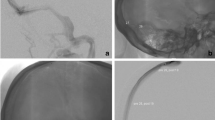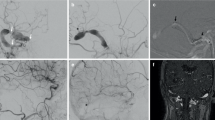Abstract
Venous sinus stenting (VSS) for medically refractory idiopathic intracranial hypertension (IIH) is emerging as a safe and effective alternative to shunting. However, stent navigation past the jugular bulb with commonly used carotid stenting systems via femoral access in cases with tortuous venous anatomy can present a challenge, leading to procedural failure. We present a technical refinement using a cervical access and peripheral vascular stent with a more stable 0.035-in. delivery platform as an alternative to the traditional approach to simplify the procedure and overcome the technical difficulties in cases with tortuous venous anatomy. Our institutional database for patients who had IIH and undergone VSS using the peripheral vascular stent between 2013 and 2023 was retrospectively reviewed. Data on 36 patients (33 women, 3 men, mean age 32 years) was collected. VSS was technically successful in all patients (100%) without major complications or thrombosis. There was one case of minor neck cellulitis treated with oral antibiotics. Three patients underwent repeat stenting, and 2 patients had ventriculoperitoneal shunt placement after stenting due to persistent or recurrent symptoms. All patients (100%) had improvement or resolution of papilledema; however, six patients had evidence of optic atrophy and persistent vision loss. Headache was resolved or improved in 91% of patients. In the presence of tortuous venous anatomy, VSS using cervical access and a peripheral vascular stent with a more stable 0.035-in. delivery platform can be considered as a safe and effective alternative approach with shorter procedure time. This approach is particularly advantageous in situations where the procedure is prolonged or high dose of contrast has been administered due to the technical challenges associated with the traditional use of carotid systems via femoral access for stent delivery.



Similar content being viewed by others
Data availability
The data that support the findings of this study are available on request from the corresponding author. The data is not publicly available due to privacy or ethical restrictions.
References
Higgins JN, Cousins C, Owler BK, Sarkies N, Pickard JD (2003) Idiopathic intracranial hypertension: 12 cases treated by venous sinus stenting. J Neurol Neurosurg Psychiatry 74(12):1662–6
Aguilar-Pérez M, Martinez-Moreno R, Kurre W et al (2017) Endovascular treatment of idiopathic intracranial hypertension: retrospective analysis of immediate and long-term results in 51 patients. Neuroradiology 59(3):277–287. https://doi.org/10.1007/s00234-017-1783-5
Ogungbo B, Roy D, Gholkar A, Mendelow AD (2003) Endovascular stenting of the transverse sinus in a patient presenting with benign intracranial hypertension. Br J Neurosurg 17(6):565–8. https://doi.org/10.1080/02688690310001627821
Leishangthem L, SirDeshpande P, Dua D, Satti SR (2019) Dural venous sinus stenting for idiopathic intracranial hypertension: an updated review. J Neuroradiol 46(2):148–154. https://doi.org/10.1016/j.neurad.2018.09.001
Nia AM, Srinivasan VM, Lall R, Kan P (2022) Dural venous sinus stenting in idiopathic intracranial hypertension: a national database study of 541 patients. World Neurosurg. https://doi.org/10.1016/j.wneu.2022.08.035
Oyemade KA, Xu TT, Brinjikji W et al (2022) Improved ophthalmic outcomes following venous sinus stenting in idiopathic intracranial hypertension. Original Research. Front Ophthalmol 2022:2. https://doi.org/10.3389/fopht.2022.910524
Al-Mufti F, Dodson V, Amuluru K et al (2020) Neuroendovascular cerebral sinus stenting in idiopathic intracranial hypertension. Interv Neurol 8(2–6):164–171. https://doi.org/10.1159/000500051
Albuquerque FC, Dashti SR, Hu YC et al (2011) Intracranial venous sinus stenting for benign intracranial hypertension: clinical indications, technique, and preliminary results. World Neurosurg 75(5–6):648–52. https://doi.org/10.1016/j.wneu.2010.11.012. (discussion 592-5)
Shields LBE, Shields CB, Yao TL, Plato BM, Zhang YP, Dashti SR (2019) Endovascular treatment for venous sinus stenosis in idiopathic intracranial hypertension: an observational study of clinical indications, surgical technique, and long-term outcomes. World Neurosurg 121:e165–e171. https://doi.org/10.1016/j.wneu.2018.09.070
Dinkin MJ, Patsalides A (2017) Venous sinus stenting in idiopathic intracranial hypertension: results of a prospective trial. J Neuroophthalmol 37(2):113–121. https://doi.org/10.1097/WNO.0000000000000426
Shazly TA, Jadhav AP, Aghaebrahim A et al (2017) Venous sinus stenting shortens the duration of medical therapy for increased intracranial pressure secondary to venous sinus stenosis. J NeuroInterventional Surg 10:310–314
Belachew NF, Baschung S, Almiri W et al (2021) Casper versus precise stent for the treatment of patients with idiopathic intracranial hypertension. Clin Neuroradiol 31(3):853–862. https://doi.org/10.1007/s00062-021-01024-2
Patsalides A (2021) E-054 The River trial: a prospective single arm trial of stenting the transverse sigmoid sinuses with the river stent in patients with idiopathic intracranial hypertension resistant to medical therapy. J NeuroInterventional Surg 13(Suppl 1):A92–A92. https://doi.org/10.1136/neurintsurg-2021-SNIS.149
Lopes DK, Johnson AK, Tan LA (2013) Venous sinus manometry and intervention using the PrimeWire Prestige pressure guidewire: technique and initial experience. J Neurointerv Surg 5(5):458–60. https://doi.org/10.1136/neurintsurg-2012-010439
Ramos AD, Sundararajan S, Santillan A, Schwarz JT, Patsalides A (2020) Single arm access venous sinus stenting (SAVeS) technique: technical note. Interv Neuroradiol 26(4):501–505. https://doi.org/10.1177/1591019920920992
Gordon W, Abraham M (2020) Contralateral approach to transverse-sigmoid sinus stenting. Interv Neuroradiol 26(5):658–663. https://doi.org/10.1177/1591019920954940
Zyck S, Malik M, Webb M, et al (2022) Technical and clinical success after venous sinus stenting for treatment of idiopathic intracranial hypertension using a novel guide catheter for access: case series and initial multi-center experience. Interv Neuroradiol 15910199221139545. https://doi.org/10.1177/15910199221139545
Turner R, Chaudry I, Turk A (2010) E-031 070 Neuron conduit technique for intracranial delivery and deployment of 6 mm and 8 mm carotid stents in the setting of proximal vessel tortuosity. J NeuroInterventional Surg 2(Suppl 1):A38–A38. https://doi.org/10.1136/jnis.2010.003251.31
Qureshi AI, Khan AA, Capistrant R, Qureshi MH, Xie K, Suri MF (2016) Concurrent angioplasty balloon placement for stent delivery through jugular venous bulb for treating cerebral venous sinus stenosis Technical Report. J Vasc Interv Neurol 9(2):55–61
Schwarz J, Santillan A, Patsalides A (2020) Safely traversing venous sinus stenosis: the “Cobra” technique. Interv Neuroradiol 26(2):231–234. https://doi.org/10.1177/1591019919894802
Guédon A, Labeyrie MA, Civelli V, Saint-Maurice JP, Houdart E (2021) Navigability of a long sheath in the lateral dural sinuses facilitated by the pilot balloon technique: technical note. Neuroradiology 63(12):2149–2151. https://doi.org/10.1007/s00234-021-02776-x
Zhao Y-G, Lü B, Wang J, Cui F, Cao X-Y, Li B-M (2022) Application of “Olive-Tipped” technique during cerebral venous sinus stenosis stenting. Chinese J Contemp Neurol Neurosurg 22(6):472–477
Suh SY, Kim SJ (2013) IIH with normal CSF pressures? Indian J Ophthalmol 61(11):681–2. https://doi.org/10.4103/0301-4738.119416
Bilgin C, Oliver AA, Cutsforth-Gregory JK et al (2023) Zilver stent versus Carotid Wallstent for endovascular treatment of idiopathic intracranial hypertension. J Neurointerv Surg. https://doi.org/10.1136/jnis-2022-019659
Voûte MT, Hendriks JM, van Laanen JH et al (2011) Radial force measurements in carotid stents: influence of stent design and length of the lesion. J Vasc Interv Radiol 22(5):661–6. https://doi.org/10.1016/j.jvir.2011.01.450
Bard® LifeStar™ Vascular Stent System. https://www.bd.com/content/dam/bdcom-assets/en/en-us/documents/products/instructions-for-use/pi/PI_LifeStar-Vascular-Stent-System_DF_EN.pdf
Acknowledgements
The authors would like to acknowledge the support staff including the anesthesiologists, nurses, and interventional radiology technicians whose contributions make the management of patients safe and efficient.
Author information
Authors and Affiliations
Contributions
Mehrnoush Gorjian: study design, data analysis and interpretation, literature review, drafting, and finalizing the manuscript. Jason Andrada: study design, data collection. Kevin Sitko, Danielle Sorte, Christopher Taylor, and Javed Khader Eliyas: revising the manuscript. Andrew Carlson: study design, revising the manuscript, final review.
Corresponding author
Ethics declarations
Ethical approval
This retrospective chart review study with waiver of informed consent was approved by the Institutional Review Board of University of New Mexico (approval number UNM HRPO 20-162).
Competing interests
The authors declare no competing interests.
Additional information
Publisher's note
Springer Nature remains neutral with regard to jurisdictional claims in published maps and institutional affiliations.
Rights and permissions
Springer Nature or its licensor (e.g. a society or other partner) holds exclusive rights to this article under a publishing agreement with the author(s) or other rightsholder(s); author self-archiving of the accepted manuscript version of this article is solely governed by the terms of such publishing agreement and applicable law.
About this article
Cite this article
Gorjian, M., Andrada, J.E., Sitko, K.R. et al. Dural venous sinus stenting technique for idiopathic intracranial hypertension in patients with tortuous venous anatomy. Neurosurg Rev 46, 177 (2023). https://doi.org/10.1007/s10143-023-02087-0
Received:
Revised:
Accepted:
Published:
DOI: https://doi.org/10.1007/s10143-023-02087-0




